








MIDWEEK UPDATE 7 AUGUST 2019Plan Your Weekend……...Forthcoming Events……..Aviation News Worldwide Incidents and Accidents……This Week in Aviation History     21-31: SAC Unlimited World Championships in France. Contact Annie Boon e-mail: chunge@mweb.co.za 24: Bethlehem Airshow. Contact Stephan Fourie e-mail: fouriesj1491@gmail.com 26-31: SAPFA World Precision Flying Championships - Castellon Spain. Contact Hans Schwebel cell: 082 656 3005 e-mail: hans.s@britsgranite.co.za   7: SAAF Museum Airshow AFB Zwartkop. For more information Mark Kelbrick Cell 082 413 7577 or E-mail: markkelbrick@yahoo.com 7: SAPFA Grand Central Fun Rally - Grand Central Airport. Contact Rob Jonkers cell: 082 804 7032 e-mail: rob@aerosud.co.za 14: Vans Fly in to Kitty Hawk. Contact Frank van Heerden e-mail: frankvh@sandown.co.za. website: www.fakt.co.za 8-13: World ANR Championships - Santa Cruz Portugal - Contact Hans Schwebel e-mail: hans.s@britsgranite.co.za cell: 082 656 3005 21-22: PMS South Africa is proud to present the South African Nationals 2019, hosted by IPMS Cape Peninsula. This is the premier event on the South African scale modelling calendar and promises to attract the cream of the crop in scale plastic modelling. 24: Puma Energy Rhino Park Fly-in. Contact Juan at juan.thessner@pumaenergy.com 28: Wings & Wheels Matjhabeng Welkom airport. For more information contact Ian Buchanan 083 388 1678 or Dirk Smit 082 558 3914   19: SA Landing Championships - Brits Airfield - Contact Ron Stirk e-mail: melron@mweb.co.za cell:082 445 0373 26: SAPFA Baragwanath Fun Rally - Baragwanath Airfield. Contact Frank Eckard cell: 083 269 1516 e-mail: frank.eckard@mweb.co.za   SPORTS AEROBATIC CLUB OF SA KZN REGIONALS RESULTS 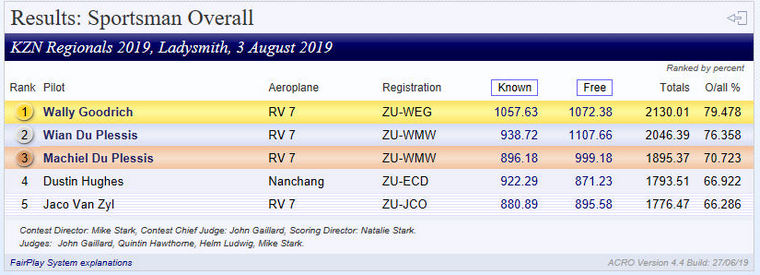      SAAF MUSEUM P/F-51 MUSTANG 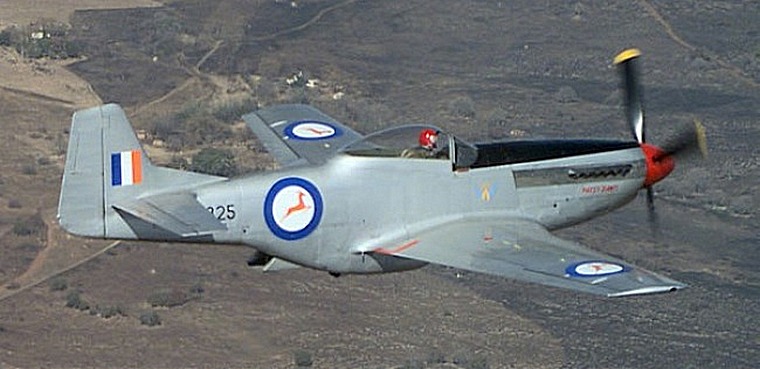 With the prospect of an extremely exciting project in the offing, Ian Grace, Chairman of the Spitfire Restoration Project, is looking to make contact with those who have the following experience, knowledge or expertise regarding the SAAF Museum Mustang, "Patsy Dawn". 1. Crew, who were involved in the restoration and or the maintenance of the North American Mustang P51D, who would consider assisting / consulting in the evaluation of the damage of the Mustang. 2. Crew, who were involved in the restoration and or the maintenance of the North American Mustang P51D, would be aware of the SAAF report detailing the extent of the damage to the Mustang, and possibly assist in obtaining a copy thereof. 3. Past SAAF members and anyone else, technical and others, who would like to assist the Friends of the SAAF Museum with a number of ongoing projects. Please circulate this request among other past SAAF Members, and anyone else who might have expertise or even just an interest. Any assistance and advice would be most gratefully received. The mooted project will bring joy to all our hearts!  AIRVENTURE 2019: FACTS AND FIGURES FOR A RECORD YEAR  "EAA members and aviation enthusiasts attended in large numbers, and stayed throughout the week. On July 22, we thanked Oshkosh residents for 50 years of support with free opening-day tickets, and more than 8,700 of them attended, which equates to 13 percent of the city's population. Throughout the rest of the week, our efforts to create unique attractions and aviation highlights across the grounds were incredibly successful in creating only-in-Oshkosh moments." "What I'm most proud of this year is how our volunteers, staff, and the community joined to overcome the challenges resulting from the massive storms that hit the airport and campground just prior to opening day. It took a true team effort to meet the additional demands on time and resources to provide services to our members and visitors." EAA CEO and Chairman of the Board Jack J. Pelton commented. Attendance: Approximately 642,000 - 6.8 percent above 2018's record total. Total aircraft: More than 10,000 aircraft arrived at Wittman Regional Airport in Oshkosh and other airports in east-central Wisconsin. At Wittman alone, there were 16,807 aircraft operations in the 11-day period from July 19-29, which is an average of approximately 127 take-offs/landings per hour. Total show planes: 2,758 including 1,057 homebuilt aircraft (including a record 592 homebuilt aircraft campsites), 939 vintage airplanes, 400 warbirds (6 percent increase), 188 ultralights and light-sport aircraft, 105 seaplanes (40 percent increase), 62 aerobatic aircraft, and 7 in other categories. Camping: More than 12,300 sites in aircraft and drive-in camping accounted for an estimated 40,000 visitors. Volunteers: More than 5,500 contributing in excess of 250,000 hours. Commercial exhibitors: 863 Forums, workshops, and presentations: A total of 1,500 sessions attended by more than 75,000 people. EAA aircraft flights: 3,051 people flew aboard EAA's Ford Tri-Motors, while 3,173 people flew aboard EAA's Bell 47 helicopters and 669 flew aboard EAA's B-17 Aluminium Overcast. Social media, internet, and mobile: More than 17.6 million people were reached by EAA's social media channels during AirVenture; EAA's website had more than 2.1 million-page views; EAA video clips during the event were viewed 4.5 million times; and EAA's 2,740 photo uploads were viewed more than 13.3 million times. Additionally, EAA web streams were accessed more than 1.6 million times by viewers in more than 200 countries, who watched more than 315,000 hours of activities from the AirVenture grounds. The AirVenture app was downloaded and used by nearly 47,000 attendees. EAA Radio reached more than 104,000 listeners in 158 countries with 6,735 hours of audio, and more than 47,000 viewers of 405,000 minutes of streaming video. Guests registered at International Visitors Tent: A record 2,772 visitors registered from 93 nations, also a record total (actual counts are higher since international visitor registration is voluntary). Top countries represented by registered visitors: Canada (561 visitors), Australia (386), and South Africa (177). The Gathering shines: The EAA Aviation Foundation's annual event to support its aviation education programs attracted some 1,400 people and raised more than $2.8 million that will be focused on EAA's mission of growing participation in aviation. Media: 851 media representatives on-site, from six continents. Economic impact*: $170 million for the five counties in the Oshkosh region (Winnebago, Outagamie, Fond du Lac, Calumet, and Brown). *Based on 2017 University of Wisconsin Oshkosh economic impact study. "Planning is well underway for next year's event, including discussions during AirVenture 2019 about possible features and attractions for 2020. In the next few months, we will be finalizing highlights in all areas to make the 68th annual EAA fly-in convention the World's Greatest Aviation Celebration." Jack commented.   CubCrafters will celebrate the 10-year anniversary of the Carbon Cub, the company's most popular airframe series, during 2019. Milestones from the Carbon Cub history will be commemorated throughout the year and will culminate in an open-invitation fly-in & reception in October, dubbed Cubfest 2019, at the company's factory headquarters in Yakima, Washington. Image © Carbon Cub. The original Carbon Cub SS, first sold in 2009 as a Light Sport Aircraft (LSA), was known for its jaw-dropping performance resulting from an all-new lightweight design incorporating a 180-horsepower engine under the cowl. The model has proven so desirable that the SS became the best-selling LSA in America, and is now the benchmark by which other STOL aircraft are judged. From the time of its launch, the Carbon Cub was a lightning rod for controversy. "The industry, the media, and even the FAA told us all that an LSA could produce no more than 100 horsepower and fly at a maximum speed of 120 miles per hour", says Jim Richmond, CubCrafters Founder & CEO. "I didn't see those limitations when I read the rule, and I knew that we could use a much more powerful engine and qualify for LSA". Carbon Cub LSAs were thus equipped with the newly developed CC340 powerplant, producing 180 horsepower. That sort of independent thinking has inspired CubCrafters' continued advancement of the Carbon Cub product line, now in its 3rd generation. But the prevalent theme has remained "less weight, more power" since inception. "The rapid development cycle at CubCrafters is ambitious compared to many GA manufacturers", comments Pat Horgan, President & COO of CubCrafters. "The Carbon Cub now has more thrust, carries heavier loads, and gets there more quickly. The newest Experimental Carbon Cubs, equipped with constant speed props and more powerful engines, produce higher thrust-to-weight ratios than any airplane in their class. The aircraft is now offered in six different versions that allow more pilots than ever to build or fly the dream Carbon Cub that perfectly fits their adventure". Celebrating a full decade of Carbon Cub adventures, Cubfest 2019 will be hosted by CubCrafters from October 11th through 13th, 2019 at McAllister Field Airport (KYKM) in Yakima, Washington. All are welcome and full program details will be announced prior to the event. Pilots, tailwheel enthusiasts, and anyone who loves aviation is encouraged to mark their calendar.  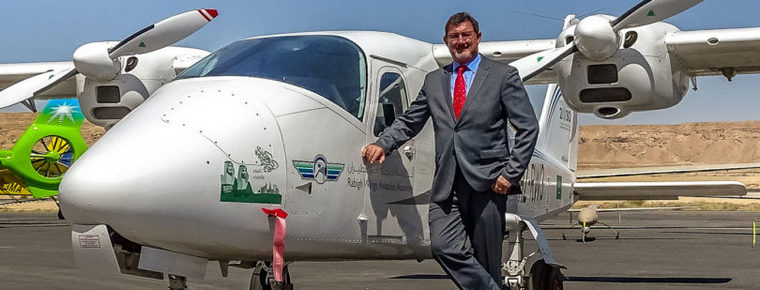 Rabigh Wings Aviation Academy (RWAA), based at Rabigh Airport Saudi Arabia, completed the factory acceptance on its second Tecnam P2006T ME trainer on 3 July 2019. RWAA is the only operational flight school in Saudi Arabia and believes in the concept of modern equipment to train modern pilots. Photo © Tecnam. This brand-new Tecnam P2006T is a twin-engine four-seat aircraft with fully retractable landing gear and will be the second P2006T aircraft in the RWAA fleet. Its simplicity, great performance, efficiency and ergonomics are what make this aircraft ideal for multi-engine training, as well as cross-country flying. The P2006T offers unbeatable value and innovative design with a modern Garmin avionics suite, integrating all primary flight, navigation, communication and terrain data on two high-definition LCDs. The aircraft is also equipped with an S-Tec 55x high-performance, two-axis autopilot, with advanced features. Fitted with two Rotax 912S3 engines, the Tecnam P2006T exhibits remarkable fuel savings and can be operated on AVGAS and MOGAS 95 octane fuel, leading to huge cost savings. At only 160 pounds each, including lubricants and coolants, the Rotax engines are at least 25 pounds lighter than other small piston engines. Acquiring the P2006T will allow RWAA to offer more flight time and a quicker way to move through multi-engine ratings. The P2006T is ideal for flight training, as the aircraft has proved to be very non stressful to fly, the controls are light to operate, and even with one engine inoperative, the pressure needed to cope with the asymmetric thrust is very low. RWAA looks forward to continuing its relationship with TECNAM Aircraft Industries to further expand its single- and multi-engine fleet. Willem Marais, General Manager, Rabigh Wings Aviation Academy said: "The RWAA training program will benefit greatly from our second Tecnam P2006T Twin. Our pilots like flying it, our instructors enjoy training in it, and our student pilots love everything about it. We look forward to adding it to our growing fleet." Walter Da Costa, Global Sales & Marketing Director, said: "We are extremely proud to partner with Rabigh Wings Aviation Academy. The team at RWAA are very committed to providing the best possible aircraft for pilot training and that's exactly what the P2006T Twin is known for - being the world's most reputable twin-engine aeroplane. We wish them continued success in the future."  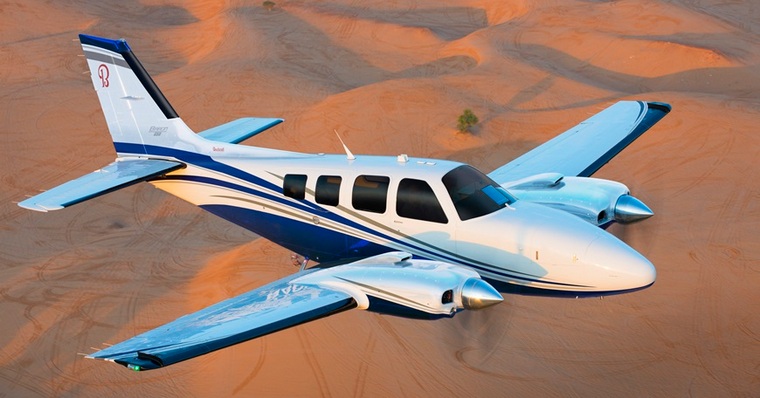 Textron Inc. (NYSE:TXT) company, this year is marking the 50th anniversary of the first flight of its Beechcraft Baron 58 high-performance piston twin, a model that has played a significant role in the company's continued leadership in the piston market. On June 23, 1969, pilots first flew the Baron 58 prototype, paving the way into the next five decades of innovative evolution. Photo © Textron. Since the Baron 58's first delivery in 1970, more than 3,100 aircraft have been delivered worldwide. The current production Beechcraft Baron G58 is on display this week at Textron Aviation's booth during the 2019 Experimental Aircraft Association (EAA) AirVenture Oshkosh at Wittman Regional Airport in Oshkosh, Wis. "Through constant innovation and technology upgrades since its introduction in 1969, the Baron 58 is the perfect combination of combination of versatility, superb performance and handling, offering the latest in technology and cockpit/cabin comfort," said Chris Crow, vice president, Piston Sales. "As the industry's fastest light twin, the Baron 58 was a success as soon as it entered the market, and our commitment to investing in the piston product line and ensuring our customers have access to the latest technology is why this airplane continues to lead the class in performance after five decades." The most recent upgrade to the Baron G58 is the addition of new standard and optional equipment as part of the Garmin G1000 NXi next-generation integrated flight deck, which provides pilots with enhanced control and connectivity in the cockpit. The new equipment - including Garmin GMA 1360 audio panel, GFC 700 Autopilot with Enhanced Automatic Flight Control System (E-AFCS) and GWX 75 Doppler weather radar - further enhances the Garmin G1000 NXi's satellite-based navigation capabilities, digital flight management tools and graphical display technologies. The Baron G58's unrivalled performance and flexibility in its segment has made it a versatile recreation and business aircraft, with missions that include training and charter. Two 300-horsepower Teledyne Continental IO 550-C engines power the Baron G58, which can carry four passengers more than 1,000 miles nonstop with a maximum cruise speed of 202 ktas. It can take off in less than 2,350 feet and only requires 2,500 feet to land at its maximum landing weight of 5,400 lb. (2,449 kg). It also features a premium cabin that provides flexible seating comfortable for two, four or six people, with the option to reconfigure and remove seats to accommodate mission needs and large baggage items.  XTI AIRCRAFT, THE DEVELOPER A BUSINESS-JET STYLE VTOL, HAS OFFICIALLY ANNOUNCED A PARTNERSHIP WITH GE AVIATION TO PROVIDE PROPULSION FOR ITS HYBRID-ELECTRIC AIRCRAFT. 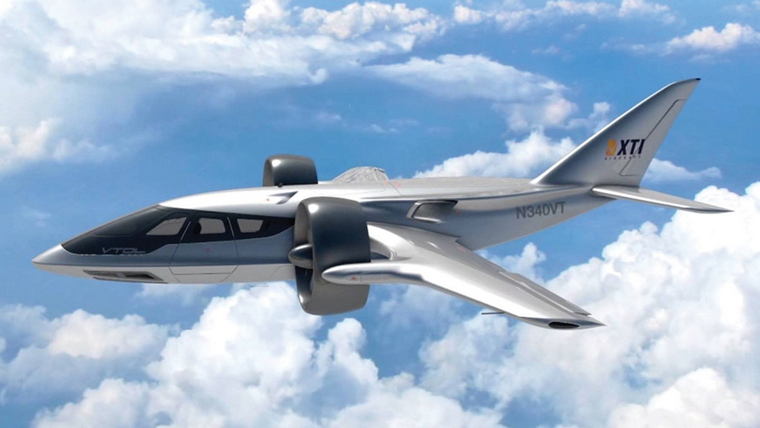 XTI Aircraft's luxury long-distance VTOL is capable of flying at 345mph for a range of 1200 nautical miles, seating five passengers, and of course, taking off and landing vertically. Image © XTI Aircraft. The company marks a major milestone this week by selecting GE's Catalyst engine as the core of its TriFan600 hybrid-electric propulsion system. GE will not only be the supplier for XTI Aircraft, but will also work closely with the company to develop a series hybrid architecture that will meet the TriFan600 performance requirements. Said GE Aviation Turboprops General Manager Paul Corkery: "GE believes that parallel and series hybrid propulsion systems, those that include a turbine gas generator to take advantage of the energy density of jet fuel, will lead to much more capable aircraft for both traditional and emerging markets for many years to come. The Catalyst is a new, clean-sheet design that will greatly reduce fuel consumption, enabling longer in-flight missions and increased payload compared to other alternatives in this class." According to GE, The Catalyst engine is the first clean-sheet turboprop engine to hit the general aviation market in more than 30 years. Operating as a series hybrid generator, the Catalyst is designed to provide the propulsion and system needs of aircraft in the emerging hybrid propulsion market. The selection of the Catalyst marks just one of many recent strides forward for XTI. The pre-order book for the TriFan600 is filling fast, having recently reached 80 aircraft. In addition, the company also recently announced partnerships with Heliflite and Icon Aviation, and released a video of its first successful prototype flight.  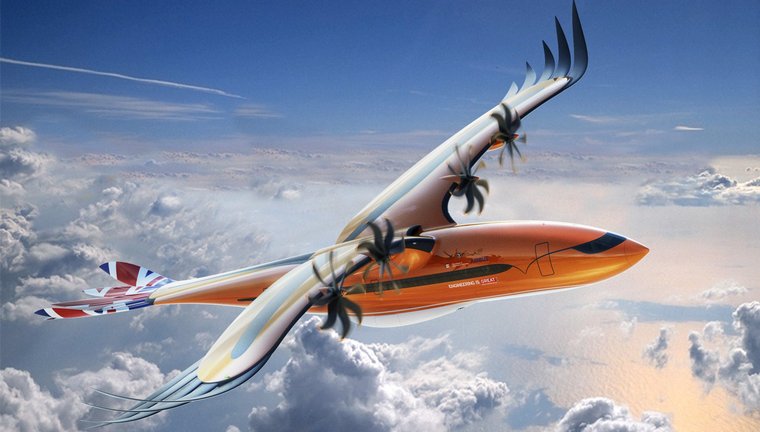 Airbus has unveiled a bird-like conceptual airliner design with the goal of motivating the next generation of aeronautical engineers, underscoring how they can make a difference by applying technologies researched at the company in hybrid-electric propulsion, active control systems and advanced composite structures. Image © Airbus. One of the priorities for the entire industry is how to make aviation more sustainable - making flying cleaner, greener and quieter than ever before. We know from our work on the A350 XWB passenger jet that through biomimicry, nature has some of the best lessons we can learn about design. While not intended to represent an actual aircraft, Airbus' "Bird of Prey" is based on realistic ideas - providing an insight into what a future regional aircraft could look like. It includes a blended wing-to-fuselage joint that mirrors the graceful and aerodynamic arch of an eagle or falcon, representing the potential of biomimicry (the design and production of materials, structures and systems inspired by nature). "Our 'Bird of Prey' is designed to be an inspiration to young people and create a 'wow' factor that will help them consider an exciting career in the crucially-important aerospace sector," explained Martin Aston, a senior manager at Airbus. "One of the priorities for the entire industry is how to make aviation more sustainable - making flying cleaner, greener and quieter than ever before. We know from our work on the A350 XWB passenger jet that through biomimicry, nature has some of the best lessons we can learn about design. Who can't help but be inspired by such a creation?" The Bird of Prey concept was unveiled at the Royal International Air Tattoo event to underscore the UK's aerospace industry leadership, and also highlights the 50th anniversary of Airbus as an aircraft manufacturer. The conceptual design initiative is backed by the GREAT Britain campaign, the Royal Aeronautical Society, the Air League, the Institution of Engineering and the Technology and Aerospace Technology Institute.   USA, Death Valley National Park: A U.S. Navy F/A-18E Super Hornet jet crashed during a routine training flight in Death Valley National Park injuring seven people who were at a scenic overlook in the area dubbed Star Wars Canyon. The seven were park visitors suffered only minor injuries. The single-seat jet was assigned to the 'Vigilantes' of Strike Fighter Squadron (VFA) 151 at Naval Air Station Lemoore. The cause of the crash and status of the pilot is currently under investigation. Canada, Addenbroke Island: A Cessna 208 Caravan operated by Seair Seaplanes was destroyed when it crashed at Addenbroke Island, approximately 82 kilometres off Vancouver Island, Canada. Four occupants from the nine onboard are confirmed dead. The remaining five occupants received unknown injures. Weather conditions at the time consisted of heavy cloud cover, moderate winds and light rain. USA, Michigan: A USAF F-16 Fighting Falcon, or "Viper", lost an access panel in flight during a practice session for the 2019 Thunder Over Michigan airshow at Willow Run Airport in Romulus, Michigan. This latest incident comes only 11 days after the same USAF F-16 Viper Demo Team pilot, in a different aircraft on loan 480th FS Warhawks from Spangdahlem Air Base, Germany, declared an in-flight emergency over RAF Fairford. The panel detached from the aircraft following a series of high-speed, high "G" manoeuvres routinely showcased during the demonstration of the F-16's maximum performance capabilities at airshows. The F-16 Demo Team completed their demonstration on Saturday normally using the second aircraft they brought to Willow Run Airport for Thunder Over Michigan. USA, Boston: A Canada BA Porter Airlines de Havilland Dash 8-400 on a flight from Toronto City to Boston (USA) with 71 people on board, was en-route at FL250 near Albany (USA) when the crew initiated an emergency descent due to the cabin altitude climbing at a very high rate, the cabin pressure warning activated. The crew worked the related checklists, determined that there was no structural damage and continued the flight to Boston at 10,000 feet for a safe landing. The Canadian TSB reported a post flight inspection revealed the aft luggage blowout panel was loose. The pressurization system was deferred according to minimum equipment list requirements and the aircraft returned to Toronto City for further maintenance. Russia, Samara: An Azimuth Sukhoi Superjet 100-95, on a flight from Krasnodar to Tyumen (Russia) with 95 people on board, was en-route at FL350 about 350nm southwest of Samara (Russia) when the left hand engine began to develop vibrations. The crew descended the aircraft to FL330, FL310 and FL270, however to no avail. The engine failed about 60nm southwest of Samara prompting the crew to shut the engine down and divert to Samara for a safe landing on runway 33 about 80 minutes after the onset of the vibrations.   28 JULY 1934 Nelly Diener becomes Europe's first air stewardess. While Ellen Evalyn Church is recorded as the first airline flight attendant, or "stewardess," Fräulein Nelly Hedwig Diener was Europe's first airline hostess. At the age of 22 years, she began flying for Swissair Schweizerische Luftverkehr-AG on 1 May 1934. She was known as the Engel der Lüfte ("Angel of the Skies").  Her 79th flight departed Zürich-Dübendorf Airport enroute Stuttgart-Echterdingen Airport and then on to Berlin. The pilot was Armin Mühlematter and radio operator/navigator was Hans Daschinger. There were nine passengers on board. The airliner was a Curtiss-Wright Airplane Division AT-32C Condor II, a one-of-a-kind variant of the AT-32 which was built specifically for Swissair. It carried identification number CH-170 on its wings and fuselage. The airliner was registered HB-LAP. The Condor was flying in a thunderstorm at approximately 3,000 meters (9,843 feet) when the right-wing structure failed and separated from the airplane. CH-170 crashed into a forest between Wurmlingen and Tuttlingen, Germany, and caught fire. All twelve persons aboard were killed.  |
                     |
 |
 |

Copyright © Pilot's Post PTY Ltd
The information, views and opinions by the authors contributing to Pilot's Post are not necessarily those of the editor or other writers at Pilot's Post.